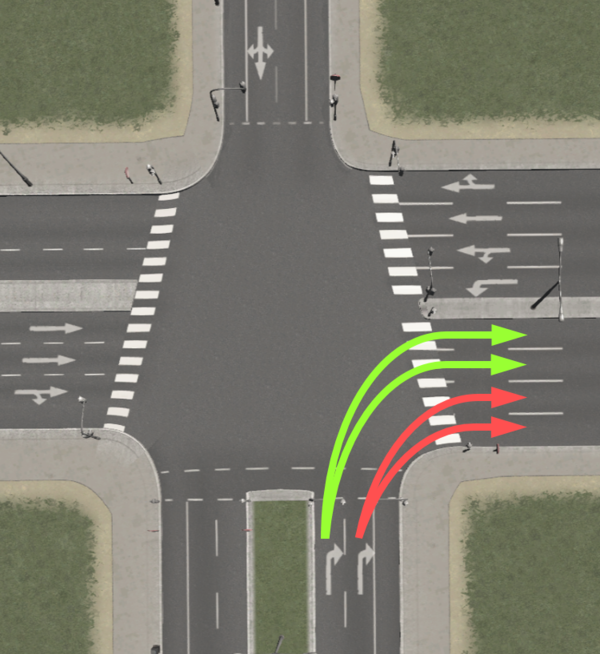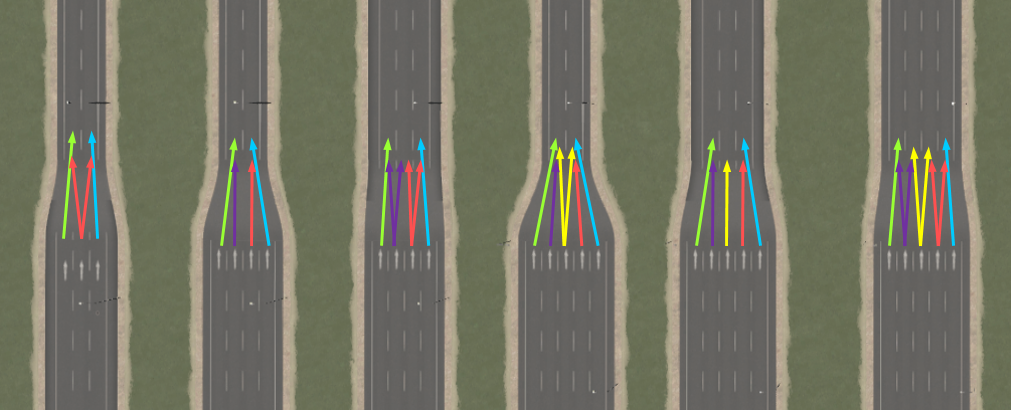👴 Junction and Transition Routing
Introduction
When TM:PE is active it modifies the way vehicles traverse junctions in order
Terminology
In order to understand how TM:PE's lane transition schemes work, you must first understand what the terms inner & outer lanes, junctions, and transitions mean in this context.
Lane Transition Schemes
TM:PE implements five different lane transition schemes for junctions and transitions:
One-to-one,
Innermost lane splits,
Symmetric split,
Innermost lanes merge, and
Crisscross merge.
They are explained in the following sections.
One To One
The simplest transition scheme is called one-to-one. It applies only at junctions where the amount of incoming lanes equals the amount of outgoing lanes for a certain direction. The image below illustrates a situation where this is the case.

With one-to-one lane mapping each incoming lane feeds exactly one outgoing lane.
Inner Lane Splits
At junctions where there exist more outgoing lanes than incoming lanes for a certain direction and the number of outgoing lanes is not divisible by the number of incoming lanes the innermost lane splits transition scheme applies. The image below illustrates a situation where this is the case.

The innermost lane splits scheme first applies one-to-one matching to all lanes except for the innermost lane (green & red arrow). The remaining lane (light blue arrow) is then divided up such that it feeds all remaining outgoing.
Symmetric Split
The symmetric split transition scheme is applied to junctions where the number of outgoing lanes is divisible by the number of incoming lanes for a certain direction. The image below illustrates a situation where this is the case.

When the symmetric split scheme is selected all incoming lanes feed an equal number of outgoing lanes. Incoming lanes are divided up evenly to all outgoing lanes in a certain direction.
Innermost Lanes Merge
At junctions where there exist less outgoing lanes than incoming lanes for a certain direction the innermost lanes merge transition scheme applies. The image below illustrates a situation where this is the case.

Starting with the outermost incoming lane the one-to-one scheme is applied until every outgoing lane is mapped to exactly one incoming lane. The remaining incoming lanes are then mapped to the innermost outgoing lane.
Crisscross Merge
The crisscross merge lane transition scheme is applied at highway transitions only. Depending on the number of incoming and outgoing lanes, lanes either merge
in a zig-zag style pattern or
in a second, two-phased pattern where central lanes proceed straight on and lanes at the edges merge towards the center.
The images below illustrate all current possible highway transitions where the criss-cross scheme is being applied.


The two merging types are applied following circumstances:
The zigzag merging scheme is applied if the number of incoming lanes is odd and the number of outgoing lanes is even, or vice versa.
The two-phased merging scheme is applied if the number of incoming and the number outgoing lanes are both odd or even.